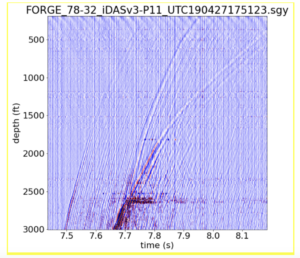A microseismic event loaded from the Frontier Observatory for Research in Geothermal Energy (FORGE) distributed acoustic sensing (DAS) data into a Jupyter notebook showing energy from a microseismic event arriving at about 7.5 seconds. These microseisms bring information about the process of stimulation. However, in the data set there are relatively few and they are hard to find without specialized processing. Connecting hard-to-get SEG-Y data to easy-to-develop Jupyter notebooks promises to drive innovation in new AI/ML methods for detecting more microseisms and therefore, increasing the value of the existing data.
Introduction
Geothermal is seriously hot right now (pun intended). Already this year, the DOE has tendered over $50 million worth of grants (here, here and here) to develop enhanced geothermal power in the United States. A $1.4 million grant was recently awarded to Rice University to adapt its DAS technologies for carbon capture and storage applications.
In Utah FORGE there are 71,880 recordings with 110 known microseismic events now visible with expert developed signal processing. Scientists can pull all the data and relevant metadata into their Jupyter notebooks and start exploring. Read on for how…
Enhanced Geothermal Systems in Brief
Conventional geothermal systems, or hydrothermal systems, occur naturally throughout the world. However, capturing enough steam or energy from heated water to generate sustainable power from them requires highly specific conditions, including sufficient heat, fluid saturation and permeability. By fracturing and pumping water through high-temperature formations, enhanced geothermal systems technology can provide the fluid content and fracture conductivity needed—but not naturally present—to produce continuous steam and energy transfer.
EGS technology has the potential to power tens of millions of homes and businesses with clean, domestic energy. The United States Geothermal Technologies Office (GTO) pursues emerging, innovative R&D initiatives that support commercially viable EGS by 2030. At the forefront of EGS is the Utah Frontier Observatory for Research in Geothermal Energy (FORGE), a first-of-its-kind accelerator for EGS pioneers.
Utah FORGE Shows the Way Forward
The mission of the Utah FORGE observatory is to enable cutting-edge well construction technologies to make commercial enhanced geothermal power possible. It provides a treasure trove of drilling, logging, completion and other geophysical data through the Geothermal Data Repository (GDR).
The Utah FORGE observatory sits above a large volume of hot crystalline granite up to six miles deep. The site provides a controlled environment where multidisciplinary researchers from universities, national laboratories, and industry partners can develop, test and optimize EGS technologies.
In 2020, researchers drilled the industry’s first deep, highly deviated geothermal well through the formation. This innovative approach, coupled with unprecedented collaboration and data dissemination, will allow a series of tests, measurements and models to facilitate the development of large-scale, economically sustainable EGS resources.
In 2021, the FORGE project is focusing its R&D efforts on zonal isolation, field-scale characterization, stimulation and well configuration for geothermal conditions.
Empowering EGS Understanding with AI/Machine Learning
Applied artificial intelligence makes the necessary understanding possible. The GDR shares open source surface and subsurface data from FORGE, including well plans, survey data, drilling data, well logs, activity reports, an interactive geoscience map, and more. These detailed datasets have the potential to revolutionize the way experts approach EGS by enabling rapid, high-quality modeling—such as fracture simulation and earth modeling—like never before.
By applying advanced machine learning technology, domain experts will be able to interpret and leverage these complex datasets at scale, often in real-time for operational decision making. New-generation deep learning applications, such as Enthought’s SubsurfaceAI Seismic, will enable scientists to optimize drilling, reservoir stimulation, well connectivity and flow testing as researchers work on developing and accelerating breakthroughs in EGS operations.
Getting to Know FORGE Data
The 110 discovered microseismic events from within the 71,880 recordings (thanks to Ariel Lelouch for sharing) are very hard to see without specialized signal processing. We’re loading the data and putting all the relevant metadata with it so you can just pull it into your Jupyter notebook and start exploring. The above image is an example.

A microseismic event loaded from the Frontier Observatory for Research in Geothermal Energy (FORGE)
distributed acoustic sensing (DAS) data into a Jupyter notebook showing energy from a microseismic event arriving at about 7.5 seconds.
At the nerd layer, there’s an opportunity for data scientists, AI experts and seismologists to learn and apply their skills to this new frontier in energy and its associated geophysics.
For access to this collection of AI/ML ready FORGE DAS data, please get in touch with Enthought.
About the Author: Ben Lasscock, holds a Ph.D. and a B.Sc. in theoretical physics from the University of Adelaide. Before coming to geoscience, Ben worked as a portfolio manager at a large hedge fund in Australia. He has publications in the areas of high energy physics, Bayesian time series analysis and geophysics.
Related Content
コンカレント材料設計:AIで実現する次世代アプローチ
AIの高度最適化、生成AI、エージェント型AIの活用により、材料と製品を同時に設計・最適化するコンカレント材料設計についてご紹介します。開発スピードと自由度が飛躍的に向上させることで、性能向上や市場投入までの期間短縮、競争優位性の確立が可能となります。
「収益性の壁」を超える:AIの活用で機能性材料開発を戦略から再構築
スペシャルティケミカルおよび素材産業は、コモディティ化と価格競争の激化により、従来の差別化戦略では持続的成長が難しくなっています。こうした中、AIやマテリアルズインフォマティクス(MI)などの先端技術が、R&D戦略の再構築と成長再加速への有力な打ち手として注目されています。
研究開発組織の変革を成功させるためのパートナー選び
現在の競争が激しいR&D環境において、適切なテクノロジーパートナーを選ぶことは、組織にとって最も重要な意思決定の1つです。理想的なパートナーとは、単なるツールベンダーやシステムインテグレーターではなく、生産性を向上させ、イノベーションを加速し、競争力を引き出す解決策を提供する科学的な専門知識と戦略的な洞察を兼ね備えた「変革の同志」です。
「AIスーパー・モデル」が材料研究開発を革新する
近年、計算能力と人工知能の進化により、材料科学や化学の研究・製品開発に変革がもたらされています。エンソートは常に最先端のツールを探求しており、研究開発の新たなステージに引き上げる可能性を持つマテリアルズインフォマティクス(MI)分野での新技術を注視しています。
デジタルトランスフォーメーション vs. デジタルエンハンスメント: 研究開発における技術イニシアティブのフレームワーク
生成AIの登場により、研究開発の方法が革新され、前例のない速さで新しい科学的発見が生まれる時代が到来しました。研究開発におけるデジタル技術の導入は、競争力を向上させることが証明されており、企業が従来のシステムやプロセスに固執することはリスクとなります。デジタルトランスフォーメーションは、科学主導の企業にとってもはや避けられない取り組みです。
産業用の材料と化学研究開発におけるLLMの活用
大規模言語モデル(LLM)は、すべての材料および化学研究開発組織の技術ソリューションセットに含むべき魅力的なツールであり、変革をもたらす可能性を秘めています。
科学研究開発における効率の重要性
今日、新しい発見や技術が生まれるスピードは驚くほど速くなっており、市場での独占期間が大幅に短縮されています。企業は互いに競争するだけでなく、時間との戦いにも直面しており、新しいイノベーションを最初に発見し、特許を取得し、市場に出すためにしのぎを削っています。
R&D イノベーションサミット2024「研究開発におけるAIの大規模活用に向けて – デジタル環境で勝ち残る研究開発組織への変革」開催レポート
去る2024年5月30日に、近年注目のAIの大規模活用をテーマに、エンソート主催のプライベートイベントがミッドタウン日比谷6FのBASE Qで開催されました。
科学研究開発における小規模データの最大活用
多くの伝統的なイノベーション主導の組織では、科学データは特定の短期的な研究質問に答えるために生成され、その後は知的財産を保護するためにアーカイブされます。しかし、将来的にデータを再利用して他の関連する質問に活用することにはあまり注意が払われません。